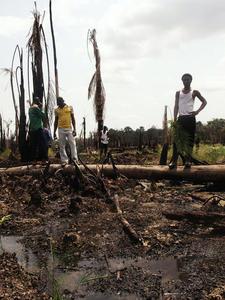Where are the most toxic places on the planet? A survey based on an assessment of danger and the risk to the greatest numbers of people has been put together, revealing mining areas, chemical waste risks, and of course Chernobyl.
The website Process Worldwide has revealed the ten most toxic places in the world by source of danger and the number of people at risk per thousand. Outside of the top ten, other data suggests that over 200 million people are at risk from toxic pollution in 49 low- and middle-income countries.
The top ten are listed below in descending order, starting with the tenth most toxic global locale.
Niger Delta, Nigeria
Oil production is affecting the region considerably. Some studies suggest it would take 30 years and at least one billion U.S. dollars to clean up the contaminated area.
Rio Motanzana, Argentina
The primary risk here is from methyl benzene in industrial wastewater, drawn from the many factories along the banks of the river affect both the water course as well as the residents in its immediate surroundings.
Accra, Ghana
In the Agbobgloshie district of the metropolis of Accra, there is an electric landfill, mostly filled with illegally imported electronic scrap from Europe. The valuable materials are mostly crudely removed with the help of open fires. Highly toxic vapours, especially in relation to lead, from the components make life difficult for people in the surrounding areas.
Norilsk, Russia
Copper, nickel oxide and other heavy metals have a severe effect on the inhabitants of the Russian City by the name of Norilsk. The life expectancy of the factory workers is ten years lower than the Russian average
Hazaribagh, Bangladesh
There are almost 100 tanneries in and around Hazaribagh. These produce more than 22,000 cubic litres of toxic waste every day, including chromium, which is affecting the life expectancy of the local population.
Kalimantan, Indonesia
In addition to rainforest destruction, the region also suffers due to the release of toxic mercury for the extraction of gold in the amalgam method. The United Nations Industrial Development Organization (UNIDO) estimates that more than 1,000 tons of mercury are released into the environment each year through this process, which constitutes about 30 percent of the anthropogenic mercury emissions.
Kabwe, Zambia
Kabwe has been affected by the mining industry. Until 1994, lead and zinc as well as cadmium, manganese and vanadium were mined without environmental requirements, and the effects are still being felt today. In particular, the fumes from the giant state-owned smelter has left the dusty soil in the surrounding area with extreme levels of lead.
Dzherzhinsk, Russia
The city is an important chemical site in Russia and it is connected with severe environmental impacts. Most of the soil and the river water is contaminated, relating to the period between 1930 and 1998 when about 300,000 tons of chemical wastes were indecorously deposited in and around the surrounding areas. Some 245,000 people live in the area.
Citarum River, Indonesia
Industrial waste and the disposal of domestic waste make the river one of the most polluted bodies of water in the world (a combination of cadmium, chromium, and pesticides). The Citarum has been called the world’s most polluted river. Around 5 million people live in the river’s basin, and most of them rely on its flow for their water supply.
Chernobyl, Ukraine
The nuclear catastrophe of Chernobyl occurred on 26 April 1986 in Block 4 of the nuclear power plant. The accident was the first ever incident to be classified in the highest category of catastrophic accidents.





One Response